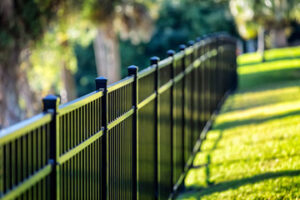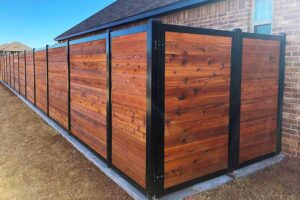Fencing is a sport that requires coordination, balance and flexibility. It’s an excellent way to keep fit and is suitable for all ages and abilities.

Picket Fence Summerville is used to protect properties. They can be made from wire, mesh or wood. They can also be permanent or temporary. They can be used to keep people and animals in or out.
Fences are an important tool for protecting people, property, and valuable assets. A fence can deter unauthorized entry and protect against theft, vandalism, and other criminal activities. In addition, proper maintenance and installation can help ensure that a fence is working effectively.
In construction sites, fencing acts as a physical barrier that prevents workers and pedestrians from entering hazardous areas. It also helps to limit distractions and provides privacy for workers. Additionally, fences can be used to control crowds and direct traffic around the site.
Depending on the type of fence, some may also feature anti-climb features to deter climbing attempts and enhance security. They may be designed with bars or mesh coverings that make it difficult for intruders to scale the fence. Incorporating a turnstile or other access control technology into the fencing system can further help to prevent unauthorized entry and maximize safety and security.
For residential properties, a fence can provide security for children and pets. This is especially helpful in neighborhoods with little or no sidewalks where children may run into the street without the supervision of their parents. It can also help to keep unwanted visitors out of the yard, such as stray dogs and cats.
Industrial fences are typically designed to enhance the safety of manufacturing operations. These fences can be equipped with sensors, video surveillance integration, and other security features to deter unauthorized entry and criminal activity. In addition, they can be designed with an appropriate height to safeguard employees from reaching dangerous points on machinery and systems.
In some instances, fences may be involved in the sale or distribution of stolen goods. This can lead to criminal charges, depending on the circumstances and value of the stolen items. In these cases, fences are referred to as “gatekeepers” of stolen goods. They often conceal the true identity of the stolen item and sell it for a fraction of its original value. In addition, they may disassemble the goods and resell them in smaller parts to avoid detection by police or pawn shops. Because of their role in the illicit trade, many law enforcement agencies are working hard to crack down on fences by conducting undercover investigations and monitoring suspicious activity.
Security
A fence is an important part of a home or business’s security. It acts as a visual deterrent to criminals, making it harder for them to enter the property or get away if they are caught. High-security fences can also act as an active security sentinel, detecting potential trespassers and alarming them, allowing occupants to take the necessary precautionary measures or notify authorities.
When choosing a fence for security, be sure to consider all possible gaps or spots where intruders can gain access. These include areas where the fencing meets the gate or guardhouse, different buildings, and other structures. Intruders often target these points because they are less secure than the rest of the fence. To make your fence more secure, consider incorporating locks into the system. A lock can be as simple as a chain and padlock. Choose a chain that is thick enough to prevent tampering and consider using shear nuts or breakaway bolts. These can snap off or shear under a certain amount of pressure, making it much more difficult to remove the bolt without breaking the chain. Alternatively, use a lock with a shear shackle that can’t be removed with tools. These shackles shear under a certain amount of force, protecting the shackle from tampering.
Fences have historically played a role in organized crime, providing a means for thieves to quickly turn their stolen goods into cash. They do this by purchasing and selling stolen items, or “fencing,” in order to turn a profit and cover their other crimes. During the early modern period, fences were also found at inns and teahouses, where they served as social hubs for criminal gangs and bandits. Later, they were seen at brothels and opium dens, as well as in shops and gambling parlors. In some cases, fences even acted as harborers for criminals, receiving stolen goods from these individuals and selling them on their behalf.
Today, fences can be equipped with motion sensors that detect the movements of intruders and trigger alarms. These can be very effective, especially when paired with other security measures like armed response and surveillance cameras. CPNI testing and accreditations, which require that a fencing product pass rigorous force entry tests, also play an important role in increasing the security of a fence.
Aesthetics
A fence is not just a boundary marker, it can also add value to your property. A well-chosen wood fence can compliment your landscaping and home, while adding privacy and security to your yard. In addition, a metal fence can add value to your property due to its durability and timeless design. However, you should consider factors such as local regulations and neighborhood preferences before making a purchase.
Colors are one way to enhance the aesthetics of a fence. While white is a traditional choice, other colors can provide a dramatic or subtle effect. A light gray fence, for example, can highlight the colors of your landscaping or home and make a small yard look larger. It also works well with most house colors, especially tan.
A darker green can accentuate the flushes of foliage on your lawn. It can also work well with shade-loving plants and trees. Moreover, dark green can make the fence blend seamlessly with nature and make your backyard seem like an extension of your garden.
Many people like to use the same color for both the fence and the gate. However, it is important to coordinate the colors of your fence with the rest of your house and landscape. It is a good idea to consult with a professional to ensure that the colors of your fence complement each other.
Other ways to enhance the aesthetics of a fence include using unique features and getting creative with paint or stain. For example, you can incorporate a stone or brick pillar into the design of your fence to give it a classic and elegant look. A wrought iron fence can also add a touch of class to your backyard.
Aesthetics is a field that studies how a person responds to a work of art. Aesthetic judgments may be based on the senses, emotions, intellectual opinions, desires, culture, tastes, values, subconscious behaviour, or conscious decision, depending on the particular theory of aesthetics. George Dickie, for example, argued that a person’s response to a work of art should not be judged according to the intentions of the artist, but rather on the work itself.
Maintenance
It is vital that fences be cleaned regularly to remove dirt, debris, and moss growth. This will prevent mildew and algae stains, and can add to the overall curb appeal of your home or business. A commercial wood cleaner, available from many hardware and home improvement stores, should be used to clean the surface of your fence. This cleaner will contain chlorine bleach to kill any green residue, and should be rinsed off thoroughly after it has been scrubbed.
If you have a wooden fence, it is important to look for signs of rot and check that all boards are secure in their place. Moisture from snow and rain can cause wood to contract, which can lead to loose boards over time. If you notice any areas of rot or soft or discolored wood, treat the area with a wood preservative.
Another important maintenance step for wooden fences is to stain them every three years. This will protect the wood from moisture and sun damage, extending its lifespan and improving the look of your yard. A professional can help you determine the right color stain for your fence.
Before applying stain, it is recommended that you clean the surface of your fence to prepare it for a new coat. Start by scrubbing it with a brush or power washer to remove any loose paint or debris. Once the fence is clean, sand any rough areas to provide a smooth surface for staining.
In addition to protecting your property and enhancing its appearance, maintaining your fence can also save you money in the long run. Identifying and repairing damaged sections of your fence quickly will prevent a small problem from becoming a bigger, more costly issue down the road.
Additionally, depending on your location and climate, your fence may require special care at certain times of the year. For example, removing snow buildup from your fence during winter will prevent excess weight that could cause structural damage. Similarly, in fall, it is important to clear away leaves and other debris that can trap moisture and promote rot in the wood.
